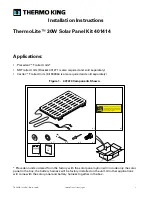
5
OPERATING PROCEDURES
TO TURN PV SYSTEM ON
1.
Turn on the PV Array DC Isolator(s) at the inverter.
2.
Then turn on the Inverter AC Isolator at the inverter (if installed) and the Solar Supply Main Switch at the
AC switchboard.
TO TURN PV SYSTEM OFF
1.
Turn off the Solar Supply Main Switch at the AC switchboard and the Inverter AC Isolator at the inverter
(if installed).
2.
Then turn off the PV Array DC Isolator(s) at the inverter.
Warning:
Depending upon the system there may be more than one PV Array DC Isolator.
Warning:
To effectively isolate the wiring between the AC isolator and switchboard, the Solar Supply
Main Switch located in the switchboard must also be in the off position.
Warning:
PV array DC isolators do not de-energise the PV array and array cabling.
ACTIONS TO UNDERTAKE IN THE EVENT OF AN EARTH FAULT ALARM
1.
Limit access to all parts of the PV system
2.
Contact Solahart Service on 1800 638 011 or your nearest Solahart dealer.
ELECTRICAL SAFETY
SAFETY REQUIREMENTS
The voltages and currents produced by a single module or modules connected in series (voltages are added
together) or in parallel (currents are added together) can be dangerous.
Note:
Only qualified personnel should perform work on photovoltaic systems.
UNIQUE HAZARDS OF DC ELECTRICITY
PV modules generate DC electricity as soon as they are exposed to sunlight. Once the current is flowing,
breaking or opening a connection (e.g. disconnecting a DC cable from the inverter) can cause a DC
electrical arc. Unlike arcs occurring in conventional low voltage AC wiring, DC arcs are not self-extinguishing.
They are a potentially lethal burn and fire hazard, capable of creating high temperatures that can destroy
contacts and connectors.
EARTH FAULTS
An earth fault is a system fault where a short circuit is formed between the DC circuitry of the PV system and
earth. As the PV system owner, please be aware of the current method of communication of earth faults on
your system. Refer to Earth Fault Alarms on page 44 for details.






































